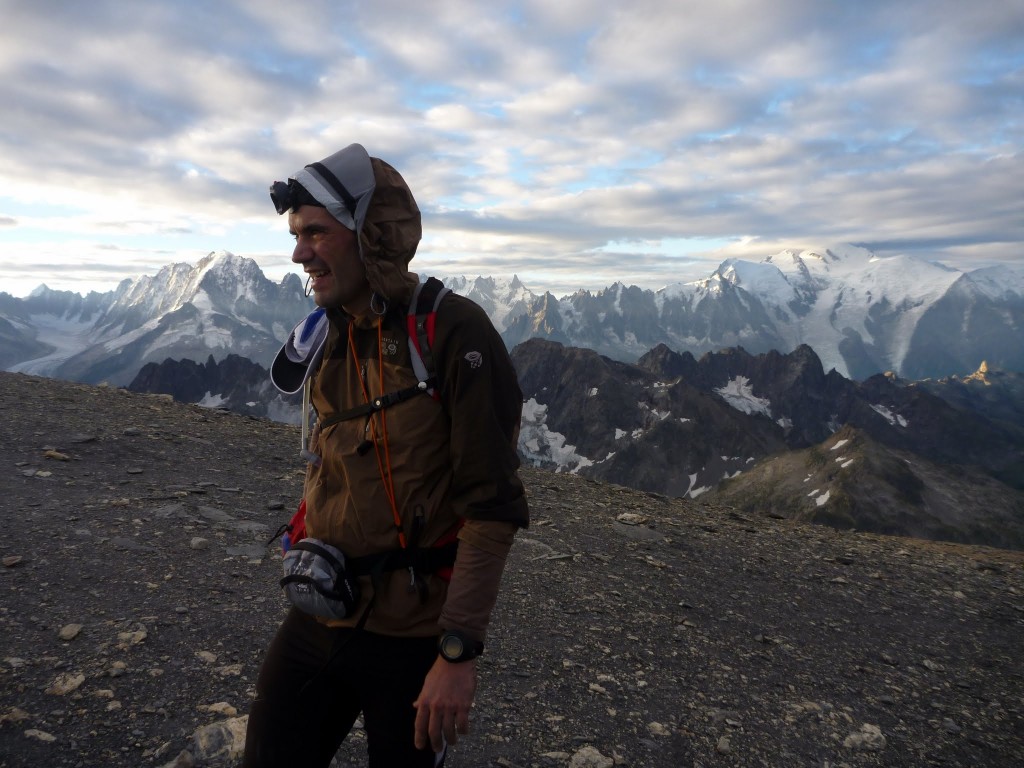
Beat Jegerlehner stands on the summit of La Buet in France during the PTL. Photo by Daniel Benhammou.
There was once a well-defined line between racers and explorers; one engaged in systematic training and competed in single-day events, and the other marked routes on maps and embarked on long, self-supported journeys.
This was also a time when a marathon was considered the ultimate distance and everyday runners operated on an entirely different realm than polar explorers and mountaineers. But over time, the lines have blurred. More runners ventured into longer distances, mountain running, and extreme climates such as deserts and tundra. Many were seeking the speed and physical engagement of running, combined with the discovery and challenge of long distances and difficult terrain. Now, even a hundred miles “is not that far,” and more competitive events are venturing into distances and regions that were once the exclusive domain of the expert explorer.
Expedition racing describes events that cover a large, real distance (i.e. not 200 miles of loops around a track), are often partially self-supported, take two or more days to complete, and run the race clock nonstop (stage races are different than a competitive expedition.) Expedition racing is also different from adventure racing in that racers start and finish with the same equipment, and whose aim is to complete a route or distance rather than engage in a set number of challenges. Expedition racers must strategize their pace and rest schedule, carry food and supplies, and stay continuously on the move. The format is growing in popularity as more “everyday runners” seek ever-greater challenges, and a bridge into the more mysterious regions of the world.
Here are a few examples of popular expedition racing events around the world. Arctic, polar, and mountain running routes have proven to be the most popular among expedition racers. However, this list is hardly exhaustive. If you know of another expedition race, please tell us about it in a comment.
Yukon Arctic Ultra, Canada, 430 miles
Starting on February 3, this consistently frigid event takes racers along the Yukon Quest Trail between Whitehorse and Dawson City, Yukon, following the same icebound route forged by gold rushers in the late nineteenth century.
Iditarod Trail Invitational, Alaska, 1,000 miles
The ITI is as close as one can come to a full expedition and still be a participant in an organized race — a thousand miles across frozen Alaskan wilderness on the Iditarod Trail, largely self-supported, with no prizes or spectators awaiting finishers in the Bering Sea town of Nome. Runners, skiers, and cyclists have thirty days to cover the distance, and the foot record is just over twenty days.
Siberian Black Ice Race, Russia, 379 miles
“Longer than England, colder than vodka and harder than granite,” this race across the black ice of Siberia is open to runners, skiers, winter cyclists, and kite skiers.
Alaska Wilderness Classic, Alaska, 150 to 250 miles
This unsupported traverse across a trail-less swath of Alaska Wilderness sets a starting point, a finishing point, and lets participants do the rest. Racers choose their own equipment, navigate their own route, and carry all of their food and supplies. The only rule is that they must be human powered, and must pack everything out. The first person or team to the finishing point wins. The grassroots event offers a summer and winter competition, and the starting/finishing point changes every three years.
Le Petite Trot a Leon, France, 300 kilometers
It is still possible to travel well off the beaten track in the French Alps, and the PTL takes runners across some of the most rugged and spectacular mountains in the region. With 24,000 meters of climbing and a 136-hour cutoff, the PTL has been described as more akin to a mountaineering challenge than a trail run. This monstrous arm of the Ultra Trail du Mont Blanc requires that participants travel in teams of two or three, and offers no finisher rankings — all who simply conquer the beast are victors.
Tor des Geants, Italy, 330 kilometers
The Tor des Geants is the grand tour of the Italian Alps, following an established route around the Aosta Valley. Although the race is well supported with six village life bases and other mountain aid stations, the rugged terrain, 80,000 feet of climbing, and nonstop clock with a 150-hour time limit establish the TDG as one of the most difficult mountain races.
South Pole Race, Antarctica, 745 kilometers
Starting on the coastline of the coldest, driest place on Earth, racers compete to be the first to reach the South Pole. Although the race organization provides travel, medical, and rescue insurance, racers are largely on their own while battling crevasses, blizzards, extreme cold, and hurricane-force winds during their trek across the continent.

Have you heard of this one? Similar to AWC, it’s the BMWO – http://bedrockandparadox.com/bob-marshall-wilderness-open/
Also, Tour Divide? Great Divide Race?
Hi Jill, great site and project. As a former glider pilot I often think how flying fits into adventure expeditions. And as a bicyclist I often cannot help myself to thi k that bikes are too mechanized form of transport unlike para gliders that are just a harness and cloth. Years ago I watched a video about the X-Alps race, which now turns out is Red Bull X-Alps. http://www.redbullxalps.com/
I think flying powered by forces of nature combined with long hikes when these forces dont cooperate, has its place in the category of races you dedicate your website to.